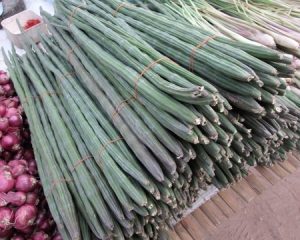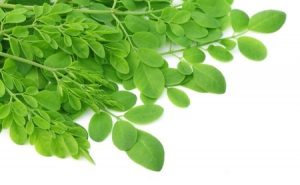
Moringa is a tropical genus of 13 species in the family Moringaceae with a strong nutritional and health story. Moringa oleifera Lam. appears to be the most nutritious of these plants and its leaves are offered as a supplement with some remarkable nutritional benefits ascribed to it (Kumar et al., 2010). It has been used for centuries in Indian folk medicine.
Alternative Names For Moringa
It is known by various names: Drumstick Tree, Benzolive, Horseradish tree, Kelor, Marango, Mlonge, Mulangay, Saijihan and Sajna. Other alternatives include:-
Arango, Árbol de las Perlas, Behen, Ben Ailé, Ben Nut Tree, Ben Oléifère, Canéficier de l’Inde, Chinto Borrego, Clarifier Tree, Indian Horseradish, Jacinto, Malunggay, Moringa pterygosperma, Moringe de Bengal, Moringe de Ceylan, Murungakai, Narango, Nebeday, Paraíso Blanco, Perla de la India, Pois Quénique, Sahjna, Saijan, Saijhan, San Jacinto, Shagara al Rauwaq, Shigru, Terebinto.
Uses
The fruit (pods) and leaves are commonly eaten in India (Ramachandran et al., 1980), Bangladesh, Nigeria and other associated countries. The pods are often cooked when young and green, and before they turn brown. In Malaysia, the young tender pods are cut into small pieces and added to curries (Abdulkarim et al., 2005).
Various health properties have been attributed to its leaves, bark, roots, flowers, fruit and seeds and research is still ongoing into all these parts of the plant. The properties of the plant have been widely reviewed (Ramachandra et al., 1980; Fahey et al., 2007; Leone et al., 2015).
There are a series of reports which cover various medicinal benefits of the plant:-
- antimicrobial activity (Bhavasar et al., 1965).
- antidiabetic activity (Caceres et al., 1992)
- liver protection (hepatotoxicity protection) (Ruckmani et al., 1998)
- immune protection (Jayanthi et al., 2015).
- anti-cancer properties (Al-Asmari et al., 2015)
The seeds contain oil and proteinaceaous materials which help coagulate materials in the clarification of water (Jahn, 1988; Ndabigengesere and Narasiah, 1998) – a great benefit in countries lacking civil infrastructure. The oil itself might even be an important source of biodiesel (Rashid et al., 2008).
Cultivation And Location
The plant is native to the sub-Himalayan areas of India, Pakistan, Bangladesh, and Afghanistan but grown over much of the tropics now. It generally needs fertile soil but is also grown in impoverished soils which extends its cultivation range.
Its versatility as a food is illustrated by the fresh pods being used for both human and animal consumption (Anjorin et al., 2010).

The Nutritional Value Of The Leaves
The leaves are claimed to offer seven times more vitamin C than oranges and 4 times more vitamin A than carrots according to advertising literature (www.perfectlynaturalherbs.com). A useful review covers its many medicinal properties (Anwar et al., 2007; Shindano and Kasase, 2009). A few studies have attempted to elaborate further on the benefits of the components in the leaf. An extract of the leaf was found to have a hypercholesterolemic effect on wistar rats, fed on a high-fat diet (Ghasi et al., 2000). Recently, a methanolic extract was tested on rats with high diet-induced obesity (Bais et al., 2014). The leaves are claimed to have anti-inflammatory activity (Ezeamuzle et al., 1996) and antitumour activity (Murakami et al., 1998). One report stated an aqueous extract of its helped regulate thyroid hormone and can be used to treat hyperthyroidism (Tahilani and Kar, 2000).
The leaves contain nutritionally important levels of copper and zinc which are important in the proper functioning of the immune system (Anwar et al., 2007). The leaves, fruits and flowers contain a rich array of carotenoids such as luteoxanthin, lutein, zeaxanthin, and β-carotene. Lutein is the major constituent of the leaves and fruits accounting for 53.6 and 52.0 % of the total carotenoids, respectively (Saini et al., 2014). The β-sitosterol, total phenolic and flavonoid compounds in the leaves of M. oleifera were reported as 90 mg/g, 8 μg/mL and 27μg/mL, respectively (Rajanandh and Kavitha, 2010). A variety of triacylglycerols have now been identified from ethanolic extracts and the fatty acids attached to these are α-linolenic acid, linoleic acid, and oleic acid (Ragasa et al., 2015).
Gas chromatography-mass spectrometry (GC-MS) analyses of methanolic extracts of the leaves (MOLE) and seeds showed the presence of 16 chemical constituents in a leaf extract with 9-octadecenoic acid (20.89%), L-(+) ascorbic acid, 2,6-dihexadecanoate (19.66%), and 14-methyl-8-hexadecenal (8.11%) as the main constituents with only five of these found in the seed extract. These were oleic acid (84%), L-(+)-ascorbic acid, 2,6-dihexadecanoate (9.80%), 9-octadecenoic acid (1.88%), methyl ester-hexadecanoic acid (1.31%) (Aja et al., 2014).
Bioassay-guided analysis of ethanolic extracts from leaves demonstrated the presence of two nitrile glycosides, niazirin and niazirinin, and three mustard oil glycosides, 4-([4′-0-acetyl-α-L-rhamnosyloxy] benzyl) isothiocyanate, niaziminin A and B (Faizi et al., 1998). These unique components are reported to possess hypotensive (blood pressure reducing), anti-cancer, and antibacterial activity.
A novel polysaccharide called MOP-2 was purified from the leaf and shown to have immunomodulatory activity in a cell line. The authors think it could have significant benefits as a stand alone ingredient in functional foods (Dong et al., 2018).

Tea Products
The leaves are a useful ingredient in a variety of herbal beverages such as a tea or an energy drink. One business, the Herbal Infusion Company distributes such a product as the brand, Miracle Tree® in the United Kingdom which is produced by Christoffel Capital B.V. This is a group of dried teas made from Moringa leaves and is claimed to be wholly vegan and organic, and certified by the Fair Trade Organisation.
The leaves by themselves have a green, slightly woody flavour with a high degree of astringency when drunk as a warm tea. These tea leaves have also been combined with seven other individual flavours such as lemon, ginger, green tea, strawberry, mango, chocolate, honey & vanilla, apple & cinnamon and with mint to provide a certain point of difference. The following claims have been made for a typical serving although that wasn’t stated:-
- 3x the potassium content of bananas
- 4x the vitamin A content in carrots
- 4x the calcium content of milk
- 7x the vitamin C content of oranges
- 9x the iron content of spinach.
The tea is said to also contain 36 different anti-inflammatories, be caffeine free, contain 47 antioxidants and also contain 25 multi-vitamins and proteins.
Breast-Feeding
Initial research suggests that taking 250 mg of a specific moringa supplement called Natalac® twice daily after childbirth increases breast milk production.
Safety Indications
The ingestion of Moringa is considered safe given that the vegetable and the leaves brewed as a tea have been consumed for centuries and assuming they have been taken responsibly. Moringa has been used safely in doses up to 6 grams daily for up to 3 weeks. However, it’s important to avoid eating the root and bark extracts because it is suggested that parts of the plant may contain a toxic substance that can cause paralysis and death.
Information on the toxicity of various parts of the plant is still being gathered.
Special Precautions & Warnings:
Pregnancy and breast-feeding: It is generally thought not safe to ingest the root, bark or flowers of moringa if pregnant. The constituents in the bark, roots and flowers can make the uterus contract, which might lead to miscarriage. There is not enough information available about the safety of using other parts of moringa during pregnancy. It is recommended to avoid use until more research becomes available that addresses this issue.
Moringa has also been taken to improve breast milk production however it is recommended that the plant be avoided if breast-feeding. Again, not enough data is available to support its use in this regard.
There are currently no known interactions or contra-indications with other drugs.
Revisions
- Additional notes about the new polysaccharide MOP-2.
References
Abdulkarim, S.M., Long, K., Lai, O.M., Muhammad, S.K.S., Ghazali, H.M. (2005). Some physio-chemical properties of Moringa oleifera seed oil extracted using solvent and aqueous enzymatic methods. Food Chem. 93: pp. 253–263.
Aja, P.M., Nwachukwu, N., Ibiam, U.A., Igwenyi, I.O., Offor, C.E., Orji, U.O. (2014) Chemical constituents of Moringa oleifera leaves and seeds from Abakaliki, Nigeria. Am J Phytomed Clin Ther. 3: pp. 10–21
Anjorin, T.S., Ikokoh, P., Okolo, S. (2010). Mineral composition of Moringa oleifera leaves, pods and seeds from two regions in Abuja, Nigeria. Int. J. Agric Biol., 12 pp. 431-434.
Anwar, F., Latif, S., Ashraf, M., Gilani, A.H., (2007) Moringa oleifera: A food plant with multiple medicinal uses. Phytother. Res. 21, pp. 17–25
Ezeamuzle, I.C., Ambedederomo, A.W., Shode, F.O., Ekwebelem, S.C., (1996) Antiinflammatory effects of Moringa oleifera root extract. Int. J. Pharmacogn. 34, pp. 207–212
Dong, Z., Li, C., Huang, Q., Zhang, B., Fu, X., Liu, R.H. (2018) Characterization of a novel polysaccharide from the leaves of Moringa oleifera and its immunostimulatory activity. J. Functional Foods 49 October pp. 391-400 https://doi.org/10.1016/j.jff.2018.09.002
Fahey, J. W. (2005). Moringa oleifera: A Review of the Medical Evidence for Its Nutritional, Therapeutic, and Prophylactic Properties. Part 1. Trees for life J., 1(5), pp. 1-15.
Faizi, S., Siddiqui, B.S., Saleem, R., Aftab, K., Shaheen, F., Gilani, A.H. (1998) Hypotensive constituents from the pods of Moringa oleifera. Planta Med. Apr; 64(3) pp. 225-8.
Ghasi, S., Nwobodo, E., Ofili, J.O., (2000) Hypocholestrolemic effects of crude extract of leaf of Moringa oleifera Lam in high fat diet fed Wister rats. J. Ethnopharmacol. 69, pp. 21–25.
Jahn, S.A.A. (1988) Using Moringa seeds as coagulants in developing countries. Journal AWWA 80(6) pp. 43-50
Kumar, S.P., Mishra, D., Ghosh, G., Panda, C.S. (2010) Medicinal uses and pharmacological properties of Moringa oleifera. Int. J. Phytomedicine, 2(3), pp. 210–216
Murakami, A., Kitazonz, Y., Jiwajinda, S., Koshimizu, K., Ohigashi, H., (1998) Niaziminin, a thio carbamate from the leaves of Moringa oleifera, holds a strict structural requirement for inhibition of tumor promotor-induced Epstein- Barr virus activation. Planta Med. 64, pp. 319–323
Ndabigengesere, A., Narasiah, K.S. (1998) Quality of water treated by coagulation using Moringa oleifera seeds. Water Res. 32(3) pp. 781-791
Rajanandh, G., Kavitha, J. (2010) Int. J. Pharm. Tech. Res., 2(2), pp. 1409-1414
Ramachandran, C., Peter, K.V., Gopalakrishan, P.K., 1980. Drumstick (Moringa oleifera). A multi-purpose Indian vegetable. Economic Botany 34 (3) pp. 276–282
Ruckmani, K., Kavimani, S., Anandan, R., Jaykar, B. (1998) Effect of Moringa oleifera lam on paracetamol-induced hepatotoxicity. Indian J. Pharm. Sci. 60(1), pp. 33–35
Saini, R., Nandini, K., Shetty, P., Giridhar, P. (2014) Eur. Food Res. Tech., 238(6), pp. 971-978.
Shindano, J., Kasase, C. (2009) Moringa (Moringa oleifera): a Source of Food and Nutrition, Medicine and Industrial products. In: ACS Symp., African natural Plant Products: New Discoveries and Challenges in Chemsitry and Quality. Vol. 1021 Chapt. 24 pp. 421-467
Tahiliani, P., Kar, A. (2000) Role of Moringa oleifera leaf extract in the regulation of thyroid hormone status in adult male and female rats. Pharmacol. Res. 41(3) pp. 319-23.
Revised: 12th January 2016.

I like your articles very much. At least they are not like the Daily Mail but they always seem interesting.
Eat foods full of adrenal-supportive nutrients, such as Natural 85% chocolate brown,
leafy veggies, nuts, pumpkin or sunflower seeds, chia and flax seeds,
and natural grass-fed animal meats.